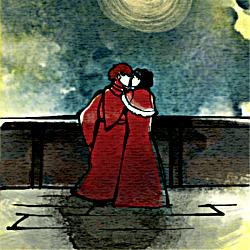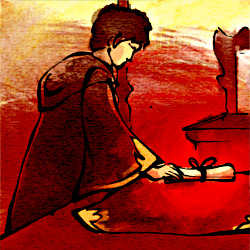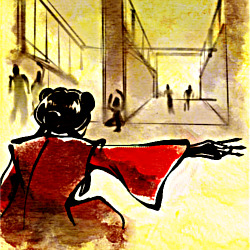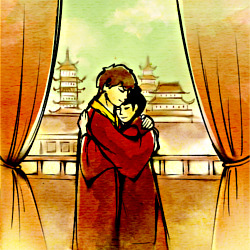Text

western air temple episode went like this right
16K notes
·
View notes
Text
It's a shame that zk shippers never used ID for their fanarts and edit it's time to take a cue from the rest of the civilized fandom

0 notes
Photo

My favorite Kyoshi quote from the second novel!
———————————————–
Scene from The Shadow of Kyoshi
Chapter: Unfinished Business (pg.10-11)
1K notes
·
View notes
Text
ATLA Meta: The Components of the Blue Spirit’s Theme
This is the Blue Spirit’s theme. It’s about a minute and ten seconds long, and an incredible amount of stuff goes into that time. I want to look at what we hear and when–and what that means. First, I am going to discuss two major moments of the theme and what they mean for Zuko; then, I will interpret other aspects of the theme and the tone they are meant to convey.
Firstly, from around 0:07-0:13, you hear three distinct, impactful bell sounds. They are loud; they are resounding; they are strong–almost like the stamping of feet. The theme begins with a statement. But what is that statement?
Well, listen to this. These are kagura suzu–a set of twelve bells used during kagura (which I will explain further down). These bells are small and higher in pitch, but if you listen to the lingering bell sound in between “impacts,” the bells in the Blue Spirit’s theme sound remarkably similar to kagura suzu.
Kagura is a ceremonial dance in the Shinto tradition. It is performed in order to please/pacify kami, which is best translated as “spirits.” Folklore surrounds the origin of kagura:
The epics Kojiki and Nihon Shoki describe a folktale origin for the dances. In these texts, there is a famous legendary tale about the sun goddess Amaterasu, who retreated into a cave, bringing darkness and cold to the world. Ame-no-Uzume, goddess of the dawn and of revelry, led the other gods in a wild dance, and persuaded Amaterasu to emerge to see what the ruckus was all about. Kagura is one of a number of rituals and arts said to derive from this event. Originally called kamukura or kamikura (神座), kagura began as sacred dances performed at the Imperial court by shrine maidens (miko) who were supposedly descendants of Ame-no-Uzume.
Kagura, in particular those forms that involve storytelling or reenactment of fables, is also one of the primary influences on the Noh theatre.
There’s a lot going on here–but folklore places kagura’s roots in the goddess of the dawn–which brings a new light and a new day. Additionally, the sound of bells was also thought to get the attention of gods so they would offer protection/wish fulfillment. Also, it’s believed that the sound of bells will ward off evil; bells are a symbol of protection–and are associated with luck.
So, what does this all mean? Why are these bells used in the beginning of the Blue Spirit’s theme?
They make a statement about how Zuko views his actions during The Blue Spirit: as fate. It is his fate to capture the Avatar; it is his fate to return to the Fire Nation; it is his fate for him to reclaim his role as the Crown Prince and reserve his right to rule. This is his singular obsession that drove him for the past two-ish years because, once again, that is his fate. Thus, when Zhao captures Aang, this is a real obstruction to his spirits-willed path, and Zuko is willing to steal and sneak in order to capture Aang–he is willing to do dishonorable things for a chance to restore his honor.
This is why the bells are used in the beginning of the theme. Zuko was born unlucky; the bells at the beginning of his theme call upon luck for his task. He is also calling on the spirits for protection–against Zhao. He wishes to capture the Avatar; this is his fate; therefore, the spirits will assist him. This doesn’t mean Zuko is literally invoking spirits in this episode, but the connection of the bells to spirits tell the listener about how Zuko views his actions: as fate, as willed by spirits.
But there’s a contradiction in the bells, too. They’re meant to ward off evil, but the Blue Spirit mask references an antagonistic force. A type of mask in Noh theatre was the Onryō mask, which often portrayed vengeful ghosts. The designs of these masks remind me of the Blue Spirit mask:

[ID: a photo of an Onryō mask used in Japanese theatre. The mask is humanoid, with two eyes, two ears, a nose, and a mouth. It is colored white. Two golden-colored horns sprout from the masks’s forehead, surrounded by wisps of painted-on black hair. The eyes are a dull gold, and the pupils are two circles cut out for the wearer’s eyes. The mask’s brows are drawn together. Its nose is wide, and its mouth is open in a snarl, revealing two rows of dull gold teeth. There are two fangs on the mask’s upper row of teeth, and two fangs on the bottom row. Its expression can be described as an anguished sneer. End ID.]
The Onryō is believed to be capable of causing great harm in the physical world by injuring or killing its enemies. There’s also the connection of kagura to Ame-no-Uzume, the goddess of the dawn. Dawn is associated with new beginnings and new light; The Blue Spirit is one of the first episodes in which the viewer realizes there is more to Zuko than meets the eye. Aang knows this, too: Do you think we could’ve been friends?
Therefore, the first few seconds of the Blue Spirit’s theme are a contradiction: a representation of treason against the Fire Nation by cheating Zhao (dishonorable), and Zuko’s own desire to be lucky, to succeed in capturing Aang and thus fulfill his fate as the spirits will it (honorable). They make a powerful statement in regards to Zuko’s intentions and thought process.
That’s the first 13 seconds. I’m not done yet.
The bells from the beginning blend seamlessly into the sound of a tsungi horn. It decrescendos to almost nothing–then there is another pound of the bell, and another crescendo of the horn, as if they are at war. This is intentional because it’s not just a tsungi horn in this theme–it’s Iroh’s song. Listen here and compare–the melodies are the same. Thus, at the beginning of the theme, the bells and the tsungi horn are at war: Zuko’s belief in his fate is musically pitted against Iroh’s influence. The bells are loud, a clashing statement! but they fade into the tsungi horn. This does not mean, however, that Iroh’s influence has won. Far from it. The notes the horn plays are long, low, and sonorous. They stretch, as though reaching for something. They are a plea, evocative of mourning, perhaps for the son Iroh has already lost, and for the son he fears losing.
Thus, this part of the theme is blatant foreshadowing. By making Iroh’s theme a part of the Blue Spirit’s theme, it seems as though the writers were wanting to make a statement about the role of the Blue Spirit in Zuko’s journey.
Those are the two large moments I wanted to talk about meaning-wise. Next, I just want to talk about the sounds and what I think they’re meant to make the listener feel.
As stated above, the notes of the tsungi horn decrescendo and crescendo, giving the listener a feeling of suspense. Around 0:36, a slow, rhythmic strumming of a strings begins, adding to said suspense. Then, the string and tsungi break off at 0:43, and what starts at 0:47 is a light tapping of a chime or bell. These urge the listener to imagine quick, light footsteps, representing the agility of the Blue Spirit–like tiptoeing. This tapping chime ebbs and flows with the tsungi horn, adding more suspense and once again adding to the aesthetic of the Blue Spirit. It’s a fantastic bit of sound that perfectly captures the imagery of blue-tinged shadows, of carefully-placed footsteps.
Around 1:05, a drum sounds, cutting off all sound. Then, the theme ends with the pounding of a drum that disappears just as quickly as it had appeared. It sounds like a heartbeat, they way it picks up and settles, as though a person has just made a choice. With that drum, the theme tapers away, just as the sound had done so many times throughout the song, leaving the listener with the impression that the Blue Spirit has more work to do: the theme, and thus all of its components, is not done yet.
All in all, I love the Blue Spirit theme. On a surface level, it invokes the perfect tone for the aesthetic of the Blue Spirit. Imo, on a deeper level, it represents Zuko’s view towards his fate and foreshadows his struggle.
327 notes
·
View notes
Text
One of the reasons why so many people has a problem with zutara is because the shippers try tear down kataang, maiko, aang and mai. The aggressiveness of zutara shippers have ruined the ship for many people. Mai and Aang aren't toxic or abusive how you like to talk. They are just kids who make mistakes in their first relationship, but still care about their partners, but you love to make them monsters who have no right to make mistakes and turn a blind eye to Zuko’s and Katara’s imperfections. You are one of the most rotten parts about the atla fandom. Why you can't enjoy zutara without bashing maiko and kataang? It's because you have a little screen time in canon? You need to leave aang, kataang, mai and maiko alone and heal cause your ship isn't canon and it never will
1 note
·
View note
Text


I just want all people to see it
17 notes
·
View notes
Photo

they’re all idiots. all four of them
12K notes
·
View notes
Text
zk fans act as if zukka shippers hypocrites because of marriage hc, while themselves make katara fire lady and take away everything about her culture in zk fan works,so who are the sexists after that?
16 notes
·
View notes
Text
one line that aang says in the southern raiders that has always stood out to me, with a little confusion, is “it’s easy to do nothing, but it’s hard to forgive.” aang is one of the most forgiving characters on the show, giving zuko numerous chances, and not having real personal bad blood with anyone - not even the fire nation for what they did to his people. that doesn’t mean he never gets angry, obviously, or that forgiveness is easy (“how could [the monks] do that to me? they wanted to take away everything i knew and everyone i loved!”) but i also don’t think aang would be saying that line as a self-congratulatory one, ie. “forgiveness is hard but i’ve done it” etc.
but then i realized that forgiveness is really hard for aang, in particular. because he struggles to forgive himself.
4K notes
·
View notes
Text
where’s the evidence that zuko helped katara with all her chores? this man was taking palanquin rides and ordering servants to fetch rose petal pastries for his gf two days before joining the gaang yet we’re supposed to believe he’s gonna be mr house husband? based on what exactly? where are the receipts?
11 notes
·
View notes
Photo

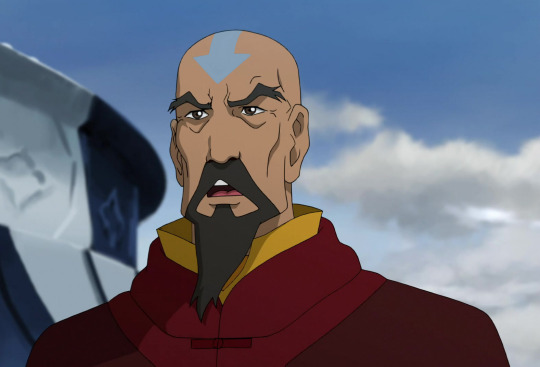
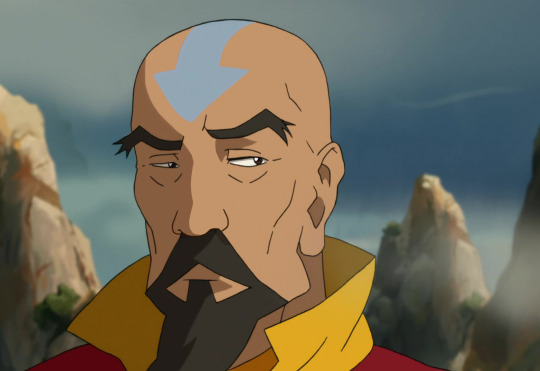
[ID: 3 edits of Tenzin from the Legend of Korra. In all 3, his skin is edited to be light brown, brown eyes, and a wider and flatter nose. In the first edit, he is shown from the chest up, facing the audience. He sits in a chair outside the Air Temple, holding his baby, Rohan. Tenzin looks at something off screen with a soft expression on his face. The second edit shows Tenzin from the shoulders up. He stands on the deck of Varrick’s ship, wearing a serious expression with his mouth open as he talks. The third shows Tenzin from the neck up. He raises an eyebrow in mild annoyance as he glances to the side, one eye only partially open. End ID.]
thanks for 1000 followers omg. here are the tenzin edits i promised 😭😭
white people can reblog but don’t comment or reply to this post.
5K notes
·
View notes
Text


I've always wanted to draw her in this meme
32 notes
·
View notes
Photo

One of my favourite episodes.
222 notes
·
View notes
Photo








Katara and Aang dancing together.
1K notes
·
View notes


